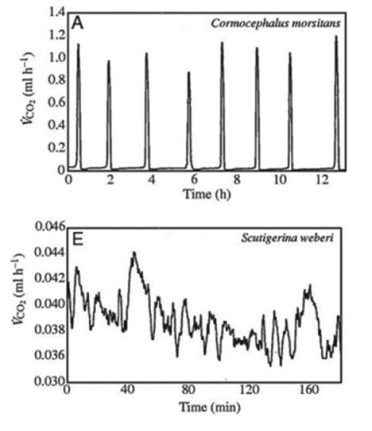Many terrestrial arthropods exchange gases with their environments by using tracheae, tubes that lead from openings (called spiracles) in the animal's exoskeleton or cuticle directly to the animal's tissues. Some arthropods can control whether their spiracles are opened or closed; opening the spiracles allows the carbon dioxide produced in the tissues to travel down the tracheae and be released outside the animal. Klok et al. measured the carbon dioxide emitted over time (represented by VCO₂) by several species of centipedes. The figures present graphs of their results for two species, Cormocephalus morsitans and Scutigerina weberi. (C. J. Klok, R. D. Mercer, and S. L. Chown. 2002. Discontinuous gas-exchange in centipedes and its convergent evolution in tracheated arthropods. Journal of Experimental Biology 205:1019-29.) Copyright 2002 The Company of Biologists and the Journal of Experimental Biology. 
Look at the graph for Scutigerina weberi (note the scale of the y-axis) in the figure.
-How would a terrestrial centipede most likely benefit from the ability to close its spiracles? Closing spiracles would ________.
Definitions:
Graves' Disease
An autoimmune disorder characterized by the overproduction of thyroid hormones, leading to hyperthyroidism.
Insomnia
A sleep disorder characterized by difficulty falling and/or staying asleep.
Weight Loss
The reduction of total body mass due to loss of fluid, fat, muscle, or other substances, potentially as a result of diet, exercise, or a medical condition.
Myxedema
A severe form of hypothyroidism characterized by swelling of the skin and tissues, especially in the face and extremities.
Q9: What is the main force by which
Q18: Which of the following is a true
Q18: Scientific views are based on evidence rather
Q22: Guppies are a common aquarium fish. They
Q29: Which of the following cell types retains
Q29: Cadherin proteins help animal cells stick (adhere)
Q34: Nematodes and arthropods both _.<br>A) develop an
Q46: Which of the following results would be
Q57: Which of the following is a correct
Q66: Elephants can often be observed cooling off